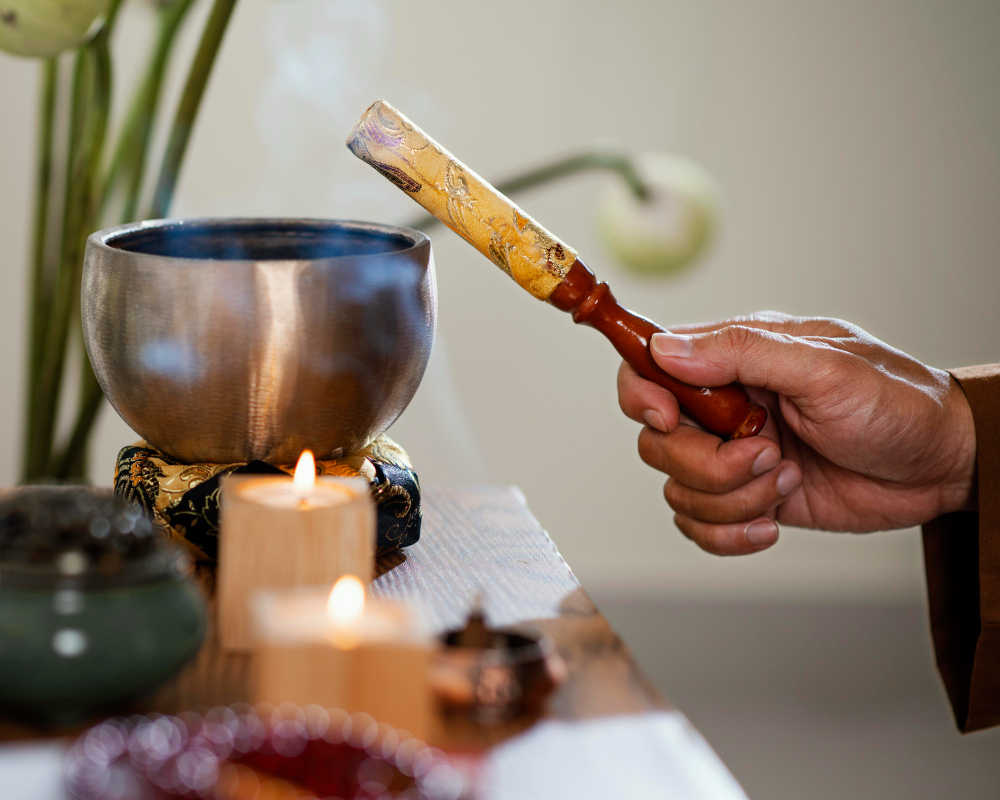Tibetan singing bowls are powerful tools used in meditation, healing, and spiritual rituals. Their origins date back thousands of years, and they have long been revered for their unique ability to create vibrational sounds that facilitate deep relaxation, balance chakras, and enhance mindfulness practices.
So, what is the best way to use a Tibetan singing bowl during rituals? I will provide an in-depth look at how to effectively use Tibetan singing bowls during rituals, covering setup, techniques, applications, and their benefits.
1. Setting Up Your Sacred Space
Before using a Tibetan singing bowl, it is crucial to create a sacred space where you can focus fully on the experience. This space should be quiet, comfortable, and free from distractions to ensure a conducive environment for relaxation and meditation. By setting up a sacred space, you cultivate a sense of ritual and reverence that allows you to deeply connect with the sound and vibration of the singing bowl.
You can place the bowl on a cushion or directly in front of you on a flat surface. You may also want to include other elements, such as candles, crystals, or an altar, to enhance the spiritual ambiance of the ritual. Intentionally setting up the space helps bring about a heightened sense of mindfulness, allowing the experience to feel more ceremonial and meaningful.
2. Choosing the Right Bowl and Tools
There are various types of Tibetan singing bowls available, with the most popular being the traditional seven-metal bowls made from a combination of metals, including gold, silver, tin, lead, zinc, iron, and copper. These bowls are known for their rich harmonic tones, which can help in meditation and energy work.
Single-metal bowls, often made of brass or bronze, produce bright and clear tones, making them ideal for focusing energy during meditation. Each type of bowl has a unique frequency, which can be used to target specific energy centers (chakras) in the body.
The choice of mallet or striker is also significant as different materials produce different sounds:
- Wooden mallets create a softer, warmer sound suitable for meditation.
- Leather-wrapped mallets provide a balanced tone that is versatile and works well with most bowls.
- Felt mallets create a mellow and ethereal tone, ideal for gentle relaxation.
Experimenting with different mallets and strikers can help you discover the sound that resonates most with you and your bowl.
3. Techniques for Playing the Tibetan Singing Bowl:
Tibetan singing bowls can be played in different ways, each providing unique benefits and experiences. Here are some common techniques on how to use Tibetan singing bowls during rituals:
- Striking Method: Hold the bowl in your non-dominant hand and strike the rim gently with the mallet. This method creates a clear, ringing tone that can fill the space with its resonance. This is a great starting point for beginners, as it requires less technique but still provides a powerful, grounding sound.
- Rimming Method: To create a continuous sound, hold the mallet firmly and run it along the outer rim of the bowl in a slow, circular motion. This requires maintaining steady pressure and speed to keep the bowl “singing.” The sound produced in this way is sustained, meditative, and helps promote a deep state of relaxation.
- Water Bowl Method: Pour water into the bowl (about ¾ cup) and circle the striker around the rim. As the bowl sings, the water will create ripples, altering the sound to produce a softened, mellow tone. This method can be particularly effective for deep, soothing healing sessions.
The key to playing the bowl effectively is to experiment with different angles, pressures, and speeds until you achieve a sound that resonates with you. When playing the bowl, focus on the sensations it creates within your body and mind, using the vibrations to enter a meditative state.
4. Incorporating Breathwork and Visualization
To enhance the experience during rituals, incorporate breathwork alongside the sound of the singing bowl. Synchronize your breath with the sound—inhale deeply as the bowl is struck and exhale slowly as the sound dissipates. This practice helps to align the body, mind, and sound, fostering a sense of unity and relaxation.
Visualization is another powerful technique. As you listen to the resonant tones, imagine the vibrations traveling through your body, clearing away tension and negative energy. Visualize the sound waves as light washing over you, bringing peace and clarity. These visualization practices can help facilitate emotional release and deeper insights during your rituals.
5. Using Tibetan Singing Bowls for Chakra Balancing
Tibetan singing bowls are often used to balance the body’s energy centers, known as chakras. Each chakra vibrates at a specific frequency, and the sound waves from a singing bowl can help to realign and balance these energies.
- Root Chakra: Use a deep, resonant tone to create a sense of stability and grounding.
- Heart Chakra: Use a bowl that resonates with a soothing tone to promote compassion, love, and emotional healing.
- Third Eye Chakra: Choose a bowl with a higher pitch to stimulate intuition and inner vision.
When using a bowl for chakra balancing, it is helpful to visualize the chakra’s color and energy as the sound resonates. For example, when focusing on the heart chakra, imagine a green light expanding from your chest, becoming brighter and clearer with each vibration. This combination of sound and visualization helps to release any blockages and restore balance.
6. Group Meditations and Sound Baths
Tibetan singing bowls can also be used in group settings such as sound baths or healing circles. In these sessions, participants typically lie down while a practitioner plays multiple bowls, creating a symphony of sound that envelops everyone present. The collective energy in the room can enhance the experience, allowing for deeper healing and connection among participants.
The communal aspect of sound baths helps foster a sense of connection and shared energy, making it an excellent way to deepen meditation practices and promote relaxation. In a group setting, the bowls’ vibrations can create a cocoon of tranquility, helping participants to feel more centered and at peace.
7. Tibetan Singing Bowls in Daily Rituals
Tibetan singing bowls are not only used for formal rituals but can also be incorporated into daily routines:
- Morning Ritual: Begin your morning with a short singing bowl session to clear your mind and set a positive tone for the day. The calming sound can help ground you and prepare you for whatever challenges lie ahead.
- Stress Relief: During moments of stress, use the singing bowl to refocus your energy. The vibrations can help you release tension and bring a sense of calm back into your day.
- Nighttime Routine: The soothing sounds of the bowl can be used as part of a bedtime ritual to release the day’s stress and prepare your mind and body for sleep.
8. Benefits of Using Tibetan Singing Bowls During Rituals
The benefits of using Tibetan singing bowls during rituals are numerous, including:
- Relaxation and Stress Reduction: The deep tones of the bowl help induce relaxation, reduce anxiety, and create a meditative state. Playing the bowl allows you to focus on the present moment, promoting mindfulness and mental clarity.
- Chakra Balancing and Energy Clearing: The vibrations from the bowl can help clear energetic blockages within the chakras, restoring balance to the body’s energy system.
- Emotional and Physical Healing: The sound frequencies produced by Tibetan singing bowls can promote emotional release and physical healing. The vibrations help to relieve tension, headaches, and muscle aches, making them an invaluable tool for those looking to improve overall well-being.
- Enhanced Meditation and Spiritual Growth: The sounds produced by the bowls have the power to alter brainwave activity, shifting the mind from a state of waking consciousness to a meditative state. This promotes deeper meditation, spiritual awareness, and emotional balance.
Advanced Techniques and Ritual Applications of Tibetan Singing Bowls
Tibetan singing bowls are not limited to simple meditation practices; they are also highly effective in more advanced rituals and spiritual work. Incorporating these bowls into ceremonies can help elevate the energy, clear negativity, and facilitate profound spiritual experiences. This section explores advanced techniques, as well as practical applications of Tibetan singing bowls in rituals to deepen their transformative power.
Rituals for Cleansing Negative Energies
Tibetan singing bowls can be effectively used to cleanse a space of negative energy. Much like sage smudging, the sound and vibrations produced by the bowls have the ability to shift stagnant or negative energy into something lighter and more positive. To conduct an energy-cleansing ritual, follow these steps:
- Set the Intention: Before starting, set a clear intention for the ritual, such as removing negative energy or filling the space with love and positivity. The power of intention will amplify the effectiveness of the ritual.
- Playing the Bowl in Corners and Entryways: Strike the singing bowl gently and let the sound fill the space. Walk around the area, focusing on corners and entryways, which are believed to trap negative energy. Use a circular motion with the mallet around the rim of the bowl as you move, allowing the vibrations to penetrate every corner of the room.
- Energy Visualization: While playing the bowl, visualize the sound as a wave of light spreading through the space, pushing away darkness and negativity. This visualization, combined with the resonant tones of the bowl, helps enhance the cleansing effect.
- Sealing the Space: After cleansing, seal the space by playing a final sustained note in the center of the room. Set an intention to hold the positive energy within the space and protect it from negative influences.
Incorporating Singing Bowls into Elemental Rituals
Tibetan singing bowls can also be used to invoke the elements—earth, air, fire, water, and spirit—during rituals. Here’s how the bowl can be used to represent or work with each element:
- Earth: Use a deep-toned bowl to symbolize the grounding energy of the earth. Play the bowl at the beginning of a grounding ritual to connect with the earth element and create a stable foundation.
- Air: The singing bowl’s sound can symbolize the movement and fluidity of air. Play a higher-pitched bowl while focusing on the breath. This can be particularly effective during rituals involving communication, inspiration, or mental clarity.
- Fire: Incorporate a bowl with a resonant and powerful tone to represent the transformative power of fire. Use it during rituals of purification or when setting strong intentions that require action and determination.
- Water: The water method, where the bowl is partially filled with water, can be used to connect with the fluid, adaptive qualities of water. This technique creates a unique sound that can be soothing and flowing, making it suitable for emotional healing rituals.
- Spirit: Singing bowls naturally have a strong connection to the spirit element. When used in rituals, they can help invoke spiritual guidance, connect with the divine, or facilitate communication with higher consciousness. Playing the bowl during meditation or a spiritual ritual can open a channel for connecting with the universe.
Singing Bowls for Ancestral and Healing Rituals
The unique vibration of Tibetan singing bowls can also be used in ancestral rituals and healing ceremonies, offering a way to connect with past energies and promote healing at deep levels.
- Ancestral Rituals: The sound of the bowls can be used to call upon ancestral spirits for guidance, protection, and support. To do this, light a candle to honor your ancestors and place it next to the bowl. As you play the bowl, visualize your ancestors being present, surrounding you with love and wisdom. Allow the sound to act as a bridge between the physical and spiritual realms, facilitating a connection that transcends time and space.
- Healing Ceremonies: Tibetan singing bowls are also used in healing ceremonies for their ability to restore energetic balance. Whether it is physical, emotional, or spiritual healing, the vibrations of the bowl can facilitate the release of blockages, allowing healing energy to flow freely. During a healing ritual, place the bowl near the area of the body that needs attention. Strike the bowl gently and use the circular motion technique to create sustained vibrations. Visualize the sound penetrating the area, dissolving pain or blockages, and promoting the body’s natural healing process.
Wrapping Up:
Tibetan singing bowls are versatile and powerful tools that can be used in rituals to promote spiritual, emotional, and physical well-being. Whether used for meditation, chakra balancing, group sound baths, or daily routines, the bowls offer a unique way to connect with the vibrations of sound and elevate your ritual practices. Hopefully, now you know how to use Tibetan singing bowls during rituals.
By creating a sacred space, choosing the right tools, and incorporating techniques like breathwork and visualization, you can experience the transformative power of Tibetan singing bowls in your own spiritual journey. Their harmonic vibrations can help you relax, heal, and connect with your higher self, making them an invaluable addition to any ritual or spiritual practice.


